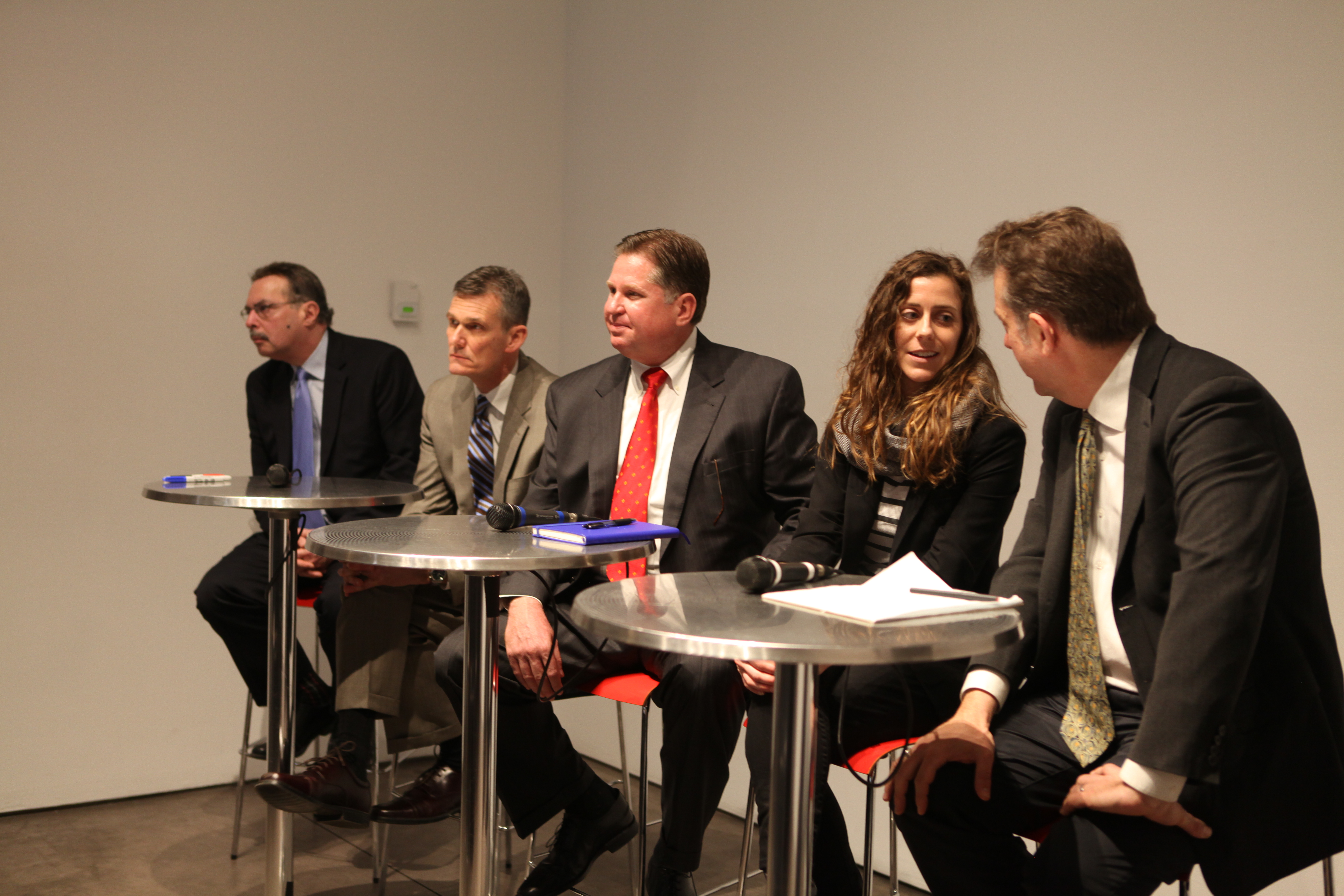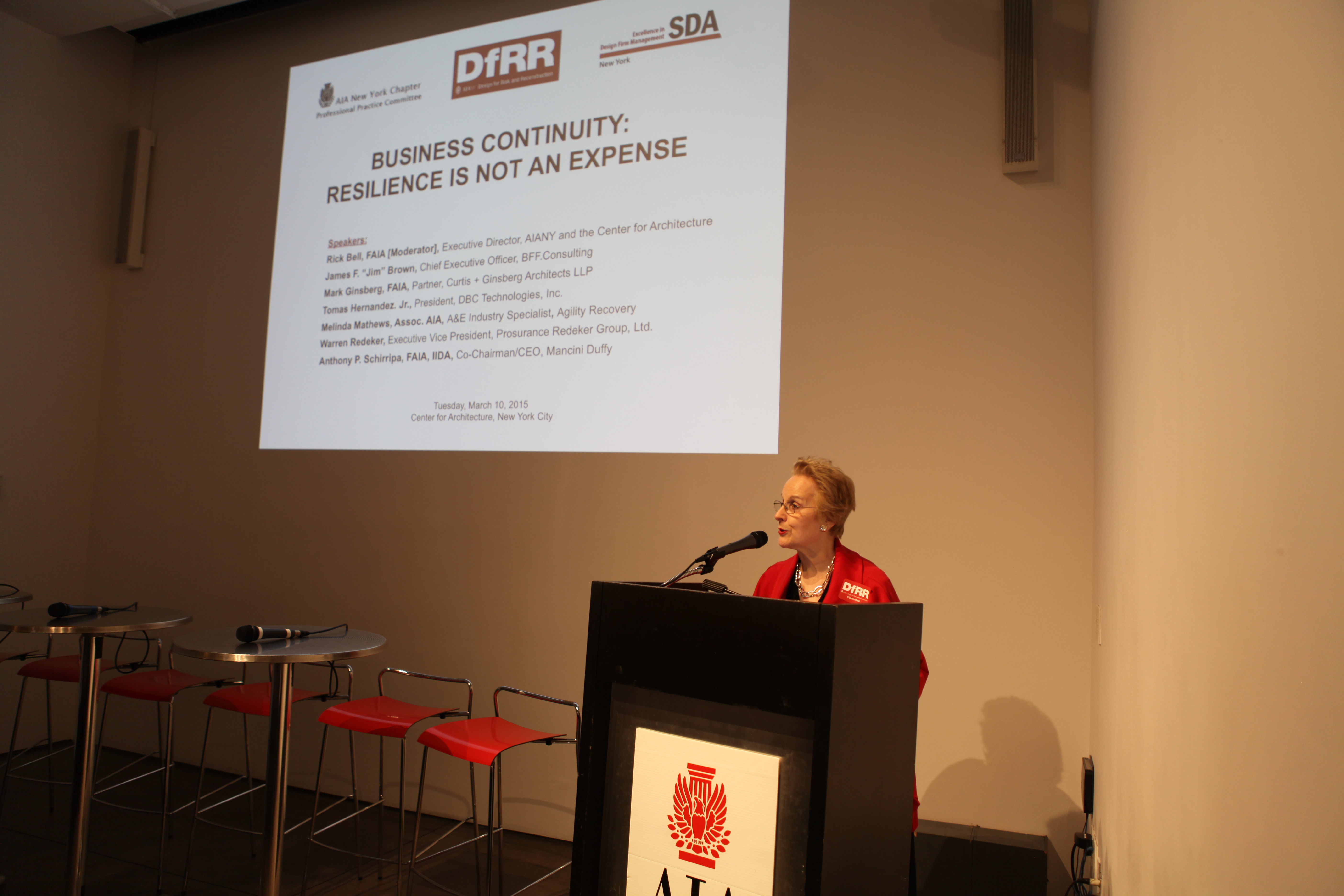by: Joan Capelin
With disasters increasingly probable, would your office be in a position to work? What problems would you and your people – as a business and as individuals – encounter?
The 03.10.15 program, “Business Continuity: Resilience is Not an Expense,” had as its mission to make people aware of the threats facing their business operations, and show them how to meet disasters head-on.
People active in helping businesses through disasters, and some who have taken their firms through disasters, formed the panel that brought a combination of design professionals, design-firm business leaders, and administrators.
The program had two messages:
- Business continuity planning is just a stronger version of business planning. Do both. You will operate more efficiently and save money.
- You have to be prepared and help yourself first, so you can help others.
Disasters come in all sizes and can happen to anyone at any time, anywhere, according to Melinda Mathews, Assoc. AIA, of Agility Recovery. She cautioned that between 40% and 60% of firms with no resiliency plan except for data recovery simply do not recover, period. “Resilience is the ability to mitigate, withstand, and recuperate effectively to a particular disruption,” she said.
What’s at stake was further articulated by Ira Tannenbaum, Assistant Commissioner for Public/Private Initiatives at the NYC Office of Emergency Management (OEM). In a disaster, he said, you are most likely going to be pulled in two directions: work and home. “Which will take priority?” he asked, underscoring one of the key problems even the most prepared office will encounter.
Everyone warned that the next disaster will be different from the last, so you have to be generally well primed. Here are 25 takeaways from the program:
- Don’t separate the “routine” running of an organization from company-wide efforts to prepare for disruptive risks (top of the list: natural disasters, industrial espionage, theft, terrorist attack).
- Developing a culture of resilience instills an attitude of flexible, adaptive, creative problem-solving at all times.
- Business resilience can be a competitive edge; imagine if you are up and running, and available to help clients.
- 60% of disasters are not major events (a burst pipe, lightning strike, power surge, smoke damage, computer virus).
- You may need an alternate “warm” site to work – arrange for that before you need it.
- If working from home is an option, consider how you will log in, whether you have a reliable power supply, child care, etc.
- How to prepare: Assess (risk, critical functions); create a crisis communications plan; create a business continuity plan; train your staff; and test the plan.
- In a widespread disaster, you are competing for recovery resources, so act quickly with good documentation.
- Be sure that your business interruption insurance covers lost income, payroll, and continuing expenses during recovery, including relocation and operational expenses.
- Typically, business interruption insurance excludes flood (not offered privately), earth movement, and utilities interruption (power, water, communications lines). Consider extended coverage.
- During recovery, keep track of your costs, file insurance claims promptly, document the process, and then update your continuity plan based on the experience.
- Have redundant server backup and fail-safe website and e-mail services with an emergency notification protocol.
- Valuable papers: insurance in a digital age is useless; very little is covered. Instead, have data recovery insurance so you can restore drawings and electronic files.
- Insure these at their replacement value: anything with chips, tenant improvements and betterments (landlords won’t replace these), fine arts, and renderings.
- Find out if your building has proper insurance.
- Have a list not just of your staff’s cell phone numbers, but also their home phone and e-mail; your phone account numbers; your IT people; your local BID and OEM (help and relocation); key vendors; building staff; passwords; insurance agent, attorney, bank.
- Back up your project data files, e-mail exchanges, accounting files, active directory, marketing database, and HR database.
- Scan important documents and save them in the Cloud.
- Clean up and disaster-proof your IT closet – equipment off the floor, fire and smoke protection, dry sprinklers, supplementary HVAC and lighting.
- Have two phone lines.
- Be able to transfer your landline phone calls to your cell.
- In your business continuity plan, pay attention to your most important asset – your people. Go over with each what they would do in the office and also develop scenarios for them at home. Figure out and cross-train for redundancy: who can take X’s place if X can’t make it in?
- Don’t assume that there will be money to help you re-start. There was after 9/11, but not after Sandy.
- Create awareness: start talking business continuity in the face of a disaster with all the people on the staff.
- Be appropriately neurotic about disasters.
Joan Capelin, Hon. AIA, is co-chair of the AIANY Design for Risk and Reconstruction Committee.
Event: Business Continuity: Resilience is Not an Expense
Location: Center for Architecture, 03.10.15
Speakers: James F. Brown, BFF.Consulting; Mark Ginsberg, FAIA, Curtis + Ginsberg Architects; Tomas Hernandez, Jr., DBC Technologies, Inc.; Melinda Mathews, Assoc. AIA, Industry Specialist for Agility Recovery; Warren Redeker, Prosurance Redeker Group Ltd; and Rick Bell, FAIA, Executive Director, AIANY (moderator)
Organizers: AIANY Design for Risk & Reconstruction Committee; AIANY Professional Practice Committee, and the Society for Design Administration – New York
Sponsor: Agility Recovery










